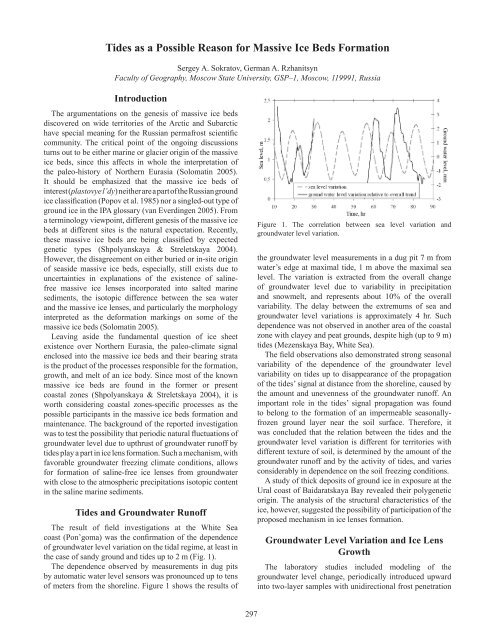Ninth International Conference on Permafrost ... - IARC Research
Ninth International Conference on Permafrost ... - IARC Research
Ninth International Conference on Permafrost ... - IARC Research
Create successful ePaper yourself
Turn your PDF publications into a flip-book with our unique Google optimized e-Paper software.
Tides as a Possible Reas<strong>on</strong> for Massive Ice Beds Formati<strong>on</strong>Sergey A. Sokratov, German A. RzhanitsynFaculty of Geography, Moscow State University, GSP–1, Moscow, 119991, RussiaIntroducti<strong>on</strong>The argumentati<strong>on</strong>s <strong>on</strong> the genesis of massive ice bedsdiscovered <strong>on</strong> wide territories of the Arctic and Subarctichave special meaning for the Russian permafrost scientificcommunity. The critical point of the <strong>on</strong>going discussi<strong>on</strong>sturns out to be either marine or glacier origin of the massiveice beds, since this affects in whole the interpretati<strong>on</strong> ofthe paleo-history of Northern Eurasia (Solomatin 2005).It should be emphasized that the massive ice beds ofinterest (plastovye l’dy) neither are a part of the Russian groundice classificati<strong>on</strong> (Popov et al. 1985) nor a singled-out type ofground ice in the IPA glossary (van Everdingen 2005). Froma terminology viewpoint, different genesis of the massive icebeds at different sites is the natural expectati<strong>on</strong>. Recently,these massive ice beds are being classified by expectedgenetic types (Shpolyanskaya & Streletskaya 2004).However, the disagreement <strong>on</strong> either buried or in-site originof seaside massive ice beds, especially, still exists due touncertainties in explanati<strong>on</strong>s of the existence of salinefreemassive ice lenses incorporated into salted marinesediments, the isotopic difference between the sea waterand the massive ice lenses, and particularly the morphologyinterpreted as the deformati<strong>on</strong> markings <strong>on</strong> some of themassive ice beds (Solomatin 2005).Leaving aside the fundamental questi<strong>on</strong> of ice sheetexistence over Northern Eurasia, the paleo-climate signalenclosed into the massive ice beds and their bearing stratais the product of the processes resp<strong>on</strong>sible for the formati<strong>on</strong>,growth, and melt of an ice body. Since most of the knownmassive ice beds are found in the former or presentcoastal z<strong>on</strong>es (Shpolyanskaya & Streletskaya 2004), it isworth c<strong>on</strong>sidering coastal z<strong>on</strong>es-specific processes as thepossible participants in the massive ice beds formati<strong>on</strong> andmaintenance. The background of the reported investigati<strong>on</strong>was to test the possibility that periodic natural fluctuati<strong>on</strong>s ofgroundwater level due to upthrust of groundwater runoff bytides play a part in ice lens formati<strong>on</strong>. Such a mechanism, withfavorable groundwater freezing climate c<strong>on</strong>diti<strong>on</strong>s, allowsfor formati<strong>on</strong> of saline-free ice lenses from groundwaterwith close to the atmospheric precipitati<strong>on</strong>s isotopic c<strong>on</strong>tentin the saline marine sediments.Tides and Groundwater RunoffThe result of field investigati<strong>on</strong>s at the White Seacoast (P<strong>on</strong>’goma) was the c<strong>on</strong>firmati<strong>on</strong> of the dependenceof groundwater level variati<strong>on</strong> <strong>on</strong> the tidal regime, at least inthe case of sandy ground and tides up to 2 m (Fig. 1).The dependence observed by measurements in dug pitsby automatic water level sensors was pr<strong>on</strong>ounced up to tensof meters from the shoreline. Figure 1 shows the results ofFigure 1. The correlati<strong>on</strong> between sea level variati<strong>on</strong> andgroundwater level variati<strong>on</strong>.the groundwater level measurements in a dug pit 7 m fromwater’s edge at maximal tide, 1 m above the maximal sealevel. The variati<strong>on</strong> is extracted from the overall changeof groundwater level due to variability in precipitati<strong>on</strong>and snowmelt, and represents about 10% of the overallvariability. The delay between the extremums of sea andgroundwater level variati<strong>on</strong>s is approximately 4 hr. Suchdependence was not observed in another area of the coastalz<strong>on</strong>e with clayey and peat grounds, despite high (up to 9 m)tides (Mezenskaya Bay, White Sea).The field observati<strong>on</strong>s also dem<strong>on</strong>strated str<strong>on</strong>g seas<strong>on</strong>alvariability of the dependence of the groundwater levelvariability <strong>on</strong> tides up to disappearance of the propagati<strong>on</strong>of the tides’ signal at distance from the shoreline, caused bythe amount and unevenness of the groundwater runoff. Animportant role in the tides’ signal propagati<strong>on</strong> was foundto bel<strong>on</strong>g to the formati<strong>on</strong> of an impermeable seas<strong>on</strong>allyfrozenground layer near the soil surface. Therefore, itwas c<strong>on</strong>cluded that the relati<strong>on</strong> between the tides and thegroundwater level variati<strong>on</strong> is different for territories withdifferent texture of soil, is determined by the amount of thegroundwater runoff and by the activity of tides, and variesc<strong>on</strong>siderably in dependence <strong>on</strong> the soil freezing c<strong>on</strong>diti<strong>on</strong>s.A study of thick deposits of ground ice in exposure at theUral coast of Baidaratskaya Bay revealed their polygeneticorigin. The analysis of the structural characteristics of theice, however, suggested the possibility of participati<strong>on</strong> of theproposed mechanism in ice lenses formati<strong>on</strong>.Groundwater Level Variati<strong>on</strong> and Ice LensGrowthThe laboratory studies included modeling of thegroundwater level change, periodically introduced upwardinto two-layer samples with unidirecti<strong>on</strong>al frost penetrati<strong>on</strong>297
















